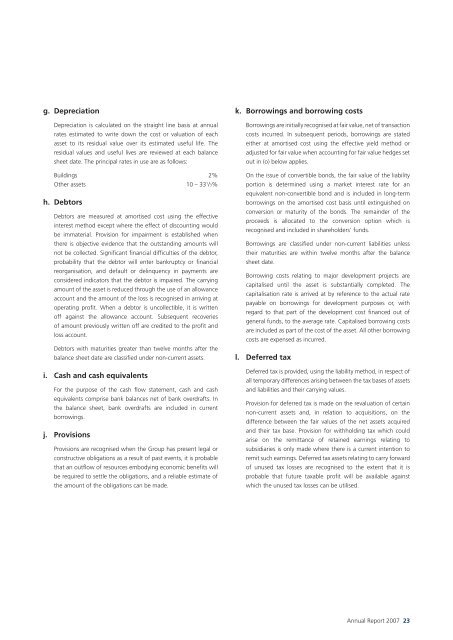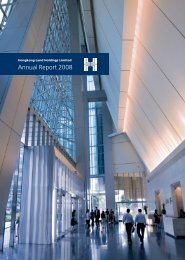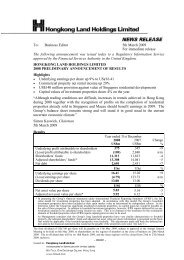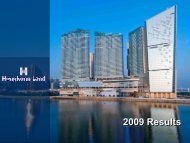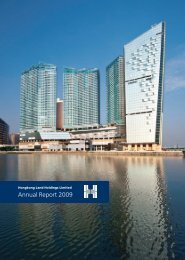Annual Report (in PDF) - Hongkong Land
Annual Report (in PDF) - Hongkong Land
Annual Report (in PDF) - Hongkong Land
Create successful ePaper yourself
Turn your PDF publications into a flip-book with our unique Google optimized e-Paper software.
g. Depreciation<br />
Depreciation is calculated on the straight l<strong>in</strong>e basis at annual<br />
rates estimated to write down the cost or valuation of each<br />
asset to its residual value over its estimated useful life. The<br />
residual values and useful lives are reviewed at each balance<br />
sheet date. The pr<strong>in</strong>cipal rates <strong>in</strong> use are as follows:<br />
Build<strong>in</strong>gs 2%<br />
Other assets 10 – 33 1 /3%<br />
h. Debtors<br />
Debtors are measured at amortised cost us<strong>in</strong>g the effective<br />
<strong>in</strong>terest method except where the effect of discount<strong>in</strong>g would<br />
be immaterial. Provision for impairment is established when<br />
there is objective evidence that the outstand<strong>in</strong>g amounts will<br />
not be collected. Significant f<strong>in</strong>ancial difficulties of the debtor,<br />
probability that the debtor will enter bankruptcy or f<strong>in</strong>ancial<br />
reorganisation, and default or del<strong>in</strong>quency <strong>in</strong> payments are<br />
considered <strong>in</strong>dicators that the debtor is impaired. The carry<strong>in</strong>g<br />
amount of the asset is reduced through the use of an allowance<br />
account and the amount of the loss is recognised <strong>in</strong> arriv<strong>in</strong>g at<br />
operat<strong>in</strong>g profit. When a debtor is uncollectible, it is written<br />
off aga<strong>in</strong>st the allowance account. Subsequent recoveries<br />
of amount previously written off are credited to the profit and<br />
loss account.<br />
Debtors with maturities greater than twelve months after the<br />
balance sheet date are classified under non-current assets.<br />
i. Cash and cash equivalents<br />
For the purpose of the cash flow statement, cash and cash<br />
equivalents comprise bank balances net of bank overdrafts. In<br />
the balance sheet, bank overdrafts are <strong>in</strong>cluded <strong>in</strong> current<br />
borrow<strong>in</strong>gs.<br />
j. Provisions<br />
Provisions are recognised when the Group has present legal or<br />
constructive obligations as a result of past events, it is probable<br />
that an outflow of resources embody<strong>in</strong>g economic benefits will<br />
be required to settle the obligations, and a reliable estimate of<br />
the amount of the obligations can be made.<br />
k. Borrow<strong>in</strong>gs and borrow<strong>in</strong>g costs<br />
Borrow<strong>in</strong>gs are <strong>in</strong>itially recognised at fair value, net of transaction<br />
costs <strong>in</strong>curred. In subsequent periods, borrow<strong>in</strong>gs are stated<br />
either at amortised cost us<strong>in</strong>g the effective yield method or<br />
adjusted for fair value when account<strong>in</strong>g for fair value hedges set<br />
out <strong>in</strong> (o) below applies.<br />
On the issue of convertible bonds, the fair value of the liability<br />
portion is determ<strong>in</strong>ed us<strong>in</strong>g a market <strong>in</strong>terest rate for an<br />
equivalent non-convertible bond and is <strong>in</strong>cluded <strong>in</strong> long-term<br />
borrow<strong>in</strong>gs on the amortised cost basis until ext<strong>in</strong>guished on<br />
conversion or maturity of the bonds. The rema<strong>in</strong>der of the<br />
proceeds is allocated to the conversion option which is<br />
recognised and <strong>in</strong>cluded <strong>in</strong> shareholders’ funds.<br />
Borrow<strong>in</strong>gs are classified under non-current liabilities unless<br />
their maturities are with<strong>in</strong> twelve months after the balance<br />
sheet date.<br />
Borrow<strong>in</strong>g costs relat<strong>in</strong>g to major development projects are<br />
capitalised until the asset is substantially completed. The<br />
capitalisation rate is arrived at by reference to the actual rate<br />
payable on borrow<strong>in</strong>gs for development purposes or, with<br />
regard to that part of the development cost f<strong>in</strong>anced out of<br />
general funds, to the average rate. Capitalised borrow<strong>in</strong>g costs<br />
are <strong>in</strong>cluded as part of the cost of the asset. All other borrow<strong>in</strong>g<br />
costs are expensed as <strong>in</strong>curred.<br />
l. Deferred tax<br />
Deferred tax is provided, us<strong>in</strong>g the liability method, <strong>in</strong> respect of<br />
all temporary differences aris<strong>in</strong>g between the tax bases of assets<br />
and liabilities and their carry<strong>in</strong>g values.<br />
Provision for deferred tax is made on the revaluation of certa<strong>in</strong><br />
non-current assets and, <strong>in</strong> relation to acquisitions, on the<br />
difference between the fair values of the net assets acquired<br />
and their tax base. Provision for withhold<strong>in</strong>g tax which could<br />
arise on the remittance of reta<strong>in</strong>ed earn<strong>in</strong>gs relat<strong>in</strong>g to<br />
subsidiaries is only made where there is a current <strong>in</strong>tention to<br />
remit such earn<strong>in</strong>gs. Deferred tax assets relat<strong>in</strong>g to carry forward<br />
of unused tax losses are recognised to the extent that it is<br />
probable that future taxable profit will be available aga<strong>in</strong>st<br />
which the unused tax losses can be utilised.<br />
<strong>Annual</strong> <strong>Report</strong> 2007 23


